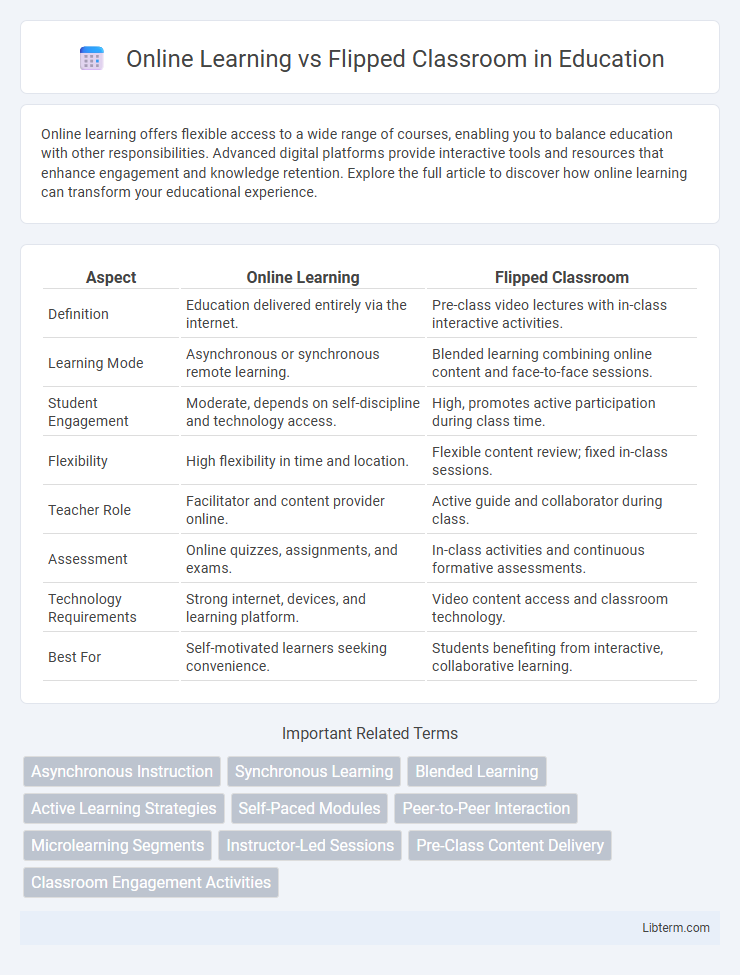Online learning offers flexible access to a wide range of courses, enabling you to balance education with other responsibilities. Advanced digital platforms provide interactive tools and resources that enhance engagement and knowledge retention. Explore the full article to discover how online learning can transform your educational experience.
Table of Comparison
| Aspect | Online Learning | Flipped Classroom |
|---|---|---|
| Definition | Education delivered entirely via the internet. | Pre-class video lectures with in-class interactive activities. |
| Learning Mode | Asynchronous or synchronous remote learning. | Blended learning combining online content and face-to-face sessions. |
| Student Engagement | Moderate, depends on self-discipline and technology access. | High, promotes active participation during class time. |
| Flexibility | High flexibility in time and location. | Flexible content review; fixed in-class sessions. |
| Teacher Role | Facilitator and content provider online. | Active guide and collaborator during class. |
| Assessment | Online quizzes, assignments, and exams. | In-class activities and continuous formative assessments. |
| Technology Requirements | Strong internet, devices, and learning platform. | Video content access and classroom technology. |
| Best For | Self-motivated learners seeking convenience. | Students benefiting from interactive, collaborative learning. |
Introduction to Online Learning and Flipped Classrooms
Online learning utilizes digital platforms to deliver educational content, enabling students to access materials anytime and anywhere, which fosters flexibility and self-paced study. Flipped classrooms invert traditional teaching by assigning instructional videos and readings for homework, freeing in-class time for interactive exercises and collaborative problem-solving. Both approaches leverage technology to enhance student engagement and accommodate diverse learning styles.
Defining Online Learning: Key Features
Online learning encompasses digital platforms that enable flexible access to educational content, allowing students to engage with multimedia resources, interactive assessments, and virtual collaboration tools anytime and anywhere. Key features include asynchronous and synchronous sessions, personalized pacing, and the integration of Learning Management Systems (LMS) to track progress and facilitate communication. This mode fosters self-directed learning while ensuring scalable delivery of courses across diverse subjects and demographics.
Understanding the Flipped Classroom Model
The flipped classroom model reverses traditional teaching by delivering instructional content online outside of class, allowing in-person sessions to focus on interactive activities, problem-solving, and personalized feedback. Unlike conventional online learning, which often relies on passive video lectures, the flipped approach encourages active engagement and collaboration during class time. This method enhances student comprehension and retention by blending self-paced digital resources with hands-on, instructor-led exercises.
Curriculum Delivery: Online vs Flipped Approaches
Online learning delivers curriculum primarily through digital platforms, offering flexible access to content such as video lectures, readings, and assessments that students can engage with independently. Flipped classroom models invert traditional teaching by providing pre-class multimedia materials online, enabling in-class time to focus on interactive activities, discussions, and personalized instruction. This approach enhances curriculum delivery by combining asynchronous content absorption with synchronous collaborative learning, optimizing student engagement and comprehension.
Learner Engagement and Interaction Comparison
Online learning offers flexible access to course materials but often lacks real-time learner interaction, resulting in challenges with sustained engagement. The flipped classroom model enhances learner engagement by combining pre-class content absorption with active, collaborative in-class activities, fostering deeper interaction among peers and instructors. Studies reveal that flipped classrooms improve participation rates and critical thinking skills compared to traditional online learning environments, emphasizing the importance of interactive pedagogy for effective education.
Flexibility and Accessibility in Both Models
Online learning offers unparalleled flexibility, allowing students to access course materials anytime and anywhere, which accommodates diverse schedules and learning paces. Flipped classrooms combine this digital accessibility with in-person engagement, providing students the ability to review lectures online before participating in interactive, face-to-face activities that enhance understanding. Both models increase accessibility by leveraging technology, but the flipped classroom uniquely balances self-paced study with collaborative, real-time feedback.
Teacher Roles and Responsibilities
In online learning, teachers primarily act as facilitators, delivering content through digital platforms and providing real-time feedback to support student engagement and understanding. In a flipped classroom, educators shift to the role of guides who design interactive in-class activities, promote critical thinking, and offer personalized assistance based on pre-class video lectures or readings. Both methods require teachers to adapt assessment strategies and foster active learning, but the flipped classroom emphasizes more direct interaction and hands-on support during class time.
Assessment and Feedback Strategies
Online learning leverages real-time quizzes and automated grading systems to provide immediate, data-driven feedback, enhancing student self-assessment and engagement. Flipped classrooms emphasize formative assessments during in-class activities, allowing instructors to offer personalized feedback and address misconceptions dynamically. Combining adaptive technology in online platforms with active, face-to-face feedback strategies in flipped classrooms optimizes overall student performance and mastery of course objectives.
Challenges and Limitations of Each Approach
Online learning faces challenges with student engagement and technology access, often leading to feelings of isolation and reduced motivation. The flipped classroom model demands significant preparation time from instructors and relies heavily on students' self-discipline to review materials outside class. Both approaches encounter difficulties in providing immediate feedback and fostering collaborative learning experiences effectively.
Choosing the Right Model: Which Suits Your Needs?
Choosing the right model between online learning and a flipped classroom depends on learner preferences, course content, and technological accessibility. Online learning offers flexibility and self-paced study, ideal for independent learners and remote access, while flipped classrooms emphasize interactive, in-person engagement and active learning during class time. Assessing individual learning styles, available resources, and educational goals ensures the selection of the most effective approach to maximize engagement and knowledge retention.
Online Learning Infographic

 libterm.com
libterm.com